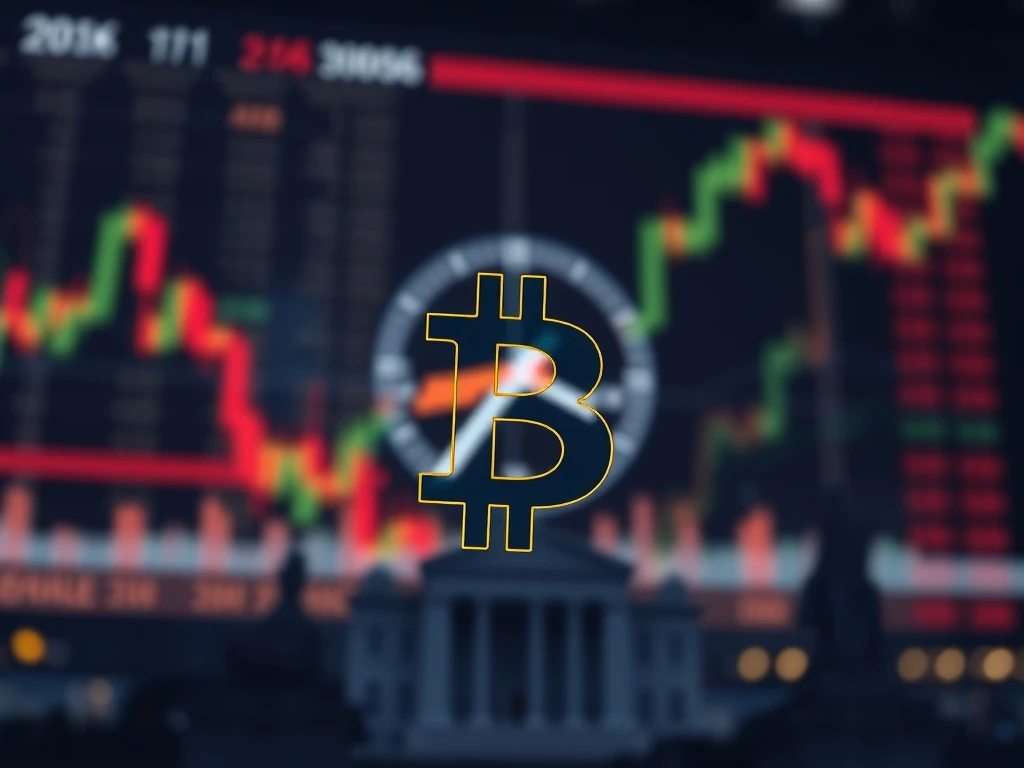Bitcoin Price Alert: Crucial Week Ahead as Traders Await Pivotal Fed Decision, Tech Earnings & ETF Flows

The cryptocurrency world is buzzing with anticipation. As the week unfolds, Bitcoin price action remains remarkably contained, hovering within a tight $116,000 to $119,000 range. This consolidation isn’t a sign of apathy; rather, it reflects a market holding its breath, keenly awaiting a series of pivotal macroeconomic and corporate announcements. From the U.S. Federal Reserve’s upcoming interest rate decision to major technology company earnings and ongoing Bitcoin and Ethereum ETF flows, this week promises to be a defining moment for Bitcoin’s near-term trajectory and broader sentiment.
Why is Bitcoin Price Holding Steady?
Bitcoin’s current subdued volatility isn’t accidental. It signals investor caution. Traders are on high alert, preferring to observe how key catalysts unfold before committing to significant directional bets. This period of low volatility often precedes a breakout, making the upcoming events even more critical. The market is digesting a lot of information, from inflation concerns to global trade dynamics, all of which contribute to this wait-and-see approach for the Bitcoin price.
The Anticipated Fed Decision: What to Expect?
Wednesday’s U.S. Federal Reserve interest rate decision is arguably the most critical event this week for the crypto market. While most analysts predict rates will remain unchanged at 4.25%-4.50%, the devil is in the details – specifically, the central bank’s commentary. Their remarks on inflation and economic growth will significantly influence investor risk appetite. Here’s what traders are watching for:
- Dovish Tone: If the Fed signals a more relaxed stance on monetary policy, perhaps hinting at future rate cuts, it could boost demand for alternative assets like Bitcoin. This would inject fresh optimism into risk-on markets.
- Hawkish Stance: Conversely, a more aggressive or cautious tone from the Fed, emphasizing continued vigilance against inflation, could dampen enthusiasm for risk assets. This might lead to a pullback in the broader market, including cryptocurrencies.
BlackRock’s chief investment officer has already voiced support for rate cuts by July 2025, citing pressures in the housing market and persistent inflation risks. The market’s reaction will hinge on whether the Fed’s communication aligns with or deviates from these expectations, setting the stage for the next phase of the crypto market.
Impact of Tech Earnings on the Crypto Market
Adding another layer of complexity, the “Magnificent 7” tech giants—including Microsoft, Apple, and Amazon—are set to publish their second-quarter earnings. Over half of S&P 500 companies will report results this month, with earnings growth generally outpacing expectations so far. These reports are crucial for several reasons:
- Positive Momentum: Strong performances from these tech titans could bolster equity markets. This often creates a positive ripple effect, indirectly supporting Bitcoin’s appeal as a high-risk asset within a buoyant financial landscape.
- Potential Headwinds: Disappointing results, however, could weigh heavily on both traditional stocks and cryptocurrencies. Investors might shift to safer assets, pulling capital away from more volatile investments.
Understanding the interplay between these traditional market indicators and the digital asset space is key. The health of the tech sector, in particular, often provides a barometer for broader economic sentiment, which in turn influences the appetite for riskier assets like Bitcoin. These tech earnings reports are not just about individual companies; they’re about the pulse of the economy.
ETF Inflows: A Steady Stream or a Trickle?
Spot Bitcoin and Ethereum ETF inflows remain a significant driver for the cryptocurrency market. Last week, spot BTC ETFs saw $72 million in inflows—the smallest gain since June. In contrast, Ethereum ETFs attracted over $5.1 billion in assets, highlighting growing institutional interest in the broader digital asset space. Evolve’s Bitcoin ETF (TSX: EBIT) has emerged as a key vehicle for institutional and retail exposure, reinforcing the idea that traditional investment avenues are increasingly embracing digital assets.
While the recent ETF inflows for Bitcoin have been modest, consistent positive flows are generally seen as a bullish signal, indicating sustained demand. However, the current range-bound environment suggests that even with these inflows, traders are waiting for more definitive clarity on macroeconomic and regulatory developments before committing to larger positions. The ongoing trend of these inflows will be a key indicator of sustained institutional adoption and market health.
Beyond the Headlines: Tariffs and Global Trade
The market will also keep a close eye on geopolitical factors, particularly proposed tariffs. Former President Trump’s tariff proposals have already contributed to higher inflation. While a last-minute agreement between the U.S. and EU avoided a trade war by imposing 15% tariffs on European exports, uncertainty remains about similar deals with other nations. A prolonged global trade conflict could exacerbate inflationary pressures, potentially undermining Bitcoin and other risk-sensitive assets. This factor, while less immediate than the Fed or earnings, adds another layer of complexity to the broader economic outlook.
Navigating the Market’s Indecision
Bitcoin’s recent price action clearly highlights the market’s indecision. After a slight slip of 1.41% in the past 24 hours, approaching $118,000, the asset has paradoxically seen a 35% surge in trading volume. This indicates heightened interest and activity, but within a confined range. It underscores traders’ reluctance to make significant directional bets until key data points provide clearer signals. The interplay between monetary policy, corporate performance, and financial product innovations underscores the deep interconnectedness of traditional and digital markets. While Bitcoin’s immediate direction is uncertain, this week’s outcomes could serve as a turning point, either solidifying its role as a hedge against inflation or exposing vulnerabilities in its growth narrative.
Actionable Insight: Investors are advised to closely monitor the Fed’s guidance, surprises from tech earnings, and trends in ETF inflows. These factors will likely dictate Bitcoin’s next phase of movement, offering potential entry or exit points for strategic traders.
Frequently Asked Questions (FAQs)
Q1: What is causing Bitcoin’s current price consolidation?
Bitcoin’s current consolidation is primarily due to investor caution ahead of major macroeconomic events. Traders are awaiting clarity from the U.S. Federal Reserve’s interest rate decision, key tech earnings reports, and ongoing Bitcoin and Ethereum ETF flow data before making significant moves.
Q2: How might the Fed’s decision impact Bitcoin?
The Fed’s commentary on inflation and economic growth, rather than just the rate decision itself, will be key. A dovish tone could boost risk appetite and benefit Bitcoin, while a hawkish stance might dampen demand for risk-on assets, potentially leading to a price correction.
Q3: Are tech earnings truly relevant to Bitcoin and the crypto market?
Yes, major tech earnings are highly relevant. Strong performances by tech giants can bolster equity markets, which often indirectly supports Bitcoin as a high-risk asset. Conversely, disappointing results could lead to a broader market downturn, affecting both stocks and cryptocurrencies as investors seek safer havens.
Q4: What do recent Bitcoin and Ethereum ETF flows indicate?
Recent ETF flows indicate continued, albeit sometimes modest, institutional and retail interest in digital assets. While Bitcoin ETF inflows saw a smaller gain last week, Ethereum ETFs attracted substantial capital. Consistent positive inflows suggest sustained demand and increasing mainstream adoption, though current market indecision means traders are still cautious.
Q5: What role do global tariffs play in the crypto market outlook?
Global tariffs, like those proposed by Trump, can exacerbate inflationary pressures. Increased inflation can undermine the purchasing power of traditional currencies, which historically has sometimes pushed investors towards assets like Bitcoin as a hedge. However, prolonged trade conflicts can also create broader economic instability, potentially dampening overall risk appetite and impacting all markets, including crypto.
Q6: Should I invest in Bitcoin now given the current uncertainty?
The decision to invest depends on individual risk tolerance and investment strategy. The current market is marked by indecision, with potential for significant price movements based on upcoming data. It is crucial to conduct thorough research, consider your financial goals, and possibly consult a financial advisor before making investment decisions in volatile markets like cryptocurrency.










